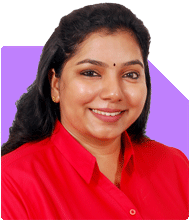Ramalingam Kalirajan |6505 Answers |Ask -Follow
Mutual Funds, Financial Planning Expert - Answered on Jul 04, 2024
He has an MBA in finance from the University of Madras and is a certified financial planner.
He is the director and chief financial planner at Holistic Investment, a Chennai-based firm that offers financial planning and wealth management advice.... more

Hello I am 45 , have homemaker spouse and 2 kids daughter 18yr and son 16 yr respectively, currently i have Home Loan balance of 5.5L, car loan 7 L. SIP of 12k monthly Gold investment of 10k monthly RD of 2k monthly. Monthly Salary 1L How can i still make my investment better
Understanding Your Financial Landscape
At 45, you’re in a critical phase of your financial journey. You have responsibilities, like children’s education, and debts, such as home and car loans. Let’s break down your current financial scenario and evaluate potential improvements.
Current Commitments
Home Loan: Rs 5.5 lakh balance.
Car Loan: Rs 7 lakh balance.
Monthly Investments:
SIPs: Rs 12,000.
Gold Investment: Rs 10,000.
Recurring Deposit (RD): Rs 2,000.
Monthly Salary: Rs 1 lakh.
Family Responsibilities
Spouse: Homemaker.
Children: Daughter (18 years old) and son (16 years old). Their education and future planning are crucial.
Optimizing Your Investment Strategy
To make your investments better, it’s important to align them with your goals, reduce debt efficiently, and ensure a balanced approach. Here’s how you can do it:
Managing and Reducing Debt
Prioritize Debt Repayment
Paying off debt quickly is crucial as it reduces financial stress and frees up cash for future investments.
Home Loan:
Home loans usually have lower interest rates and tax benefits.
Prioritize other high-interest debts first, but continue regular payments.
Car Loan:
Car loans often have higher interest rates and no tax benefits.
Consider paying off the car loan faster to reduce interest burden.
Use a Debt Snowball or Avalanche Method
These are two common strategies for debt repayment:
Debt Snowball Method:
Focus on paying off the smallest debt first while making minimum payments on larger debts.
Provides psychological motivation by achieving quick wins.
Debt Avalanche Method:
Pay off the debt with the highest interest rate first.
Reduces overall interest payments and saves more money in the long term.
Enhancing Your Investment Portfolio
Your current investments are diversified, which is great. Let's refine them for better growth and stability.
Review and Adjust SIPs
Systematic Investment Plans (SIPs) in mutual funds are excellent for long-term wealth creation. However, a regular review is essential.
Assess Performance:
Check the performance of your mutual funds.
Consult a Certified Financial Planner (CFP) to evaluate if they align with your risk tolerance and goals.
Increase SIP Amounts:
With a stable salary, consider gradually increasing your SIP contributions.
Even a small increase can significantly boost your portfolio over time.
Consider Actively Managed Funds
Instead of index funds, actively managed funds might offer better growth potential.
Professional Management:
Fund managers actively select stocks to outperform the market.
This can provide better returns, especially in volatile markets.
Higher Potential Returns:
Actively managed funds have the potential to outperform indexes.
They can adjust strategies based on market conditions.
Gold Investments
Investing in gold is a good hedge against inflation but should be balanced.
Assess Proportion:
Ensure gold doesn’t dominate your portfolio.
A diversified portfolio should limit gold to about 5-10%.
Consider Alternatives:
Look into gold ETFs or mutual funds instead of physical gold.
They offer better liquidity and storage convenience.
Optimize Recurring Deposits
Recurring Deposits (RDs) provide safety but limited returns.
Evaluate Returns:
RDs offer lower returns compared to equity or hybrid funds.
Consider shifting part of your RD investment to higher-return options.
Alternative Options:
Short-term debt funds or balanced funds could offer better returns.
They provide a balance between safety and growth.
Planning for Children’s Education
Your children’s education is a significant expense that needs careful planning.
Education Fund for Daughter
Your daughter, being 18, likely needs funds soon for higher education.
Short-Term Investments:
Use liquid funds or short-term debt funds for her immediate education needs.
These provide stability and quick access to funds.
Education Loans:
Consider an education loan for higher studies.
It spreads the cost and offers tax benefits on the interest paid.
Education Fund for Son
For your 16-year-old son, you have a bit more time to save and invest.
Medium-Term Investments:
Invest in balanced or hybrid funds for the next 2-4 years.
They offer moderate risk with potential for decent returns.
Dedicated Education Plans:
Explore child-specific mutual funds that focus on education goals.
They often have built-in safeguards and withdrawal options timed with education expenses.
Building a Robust Emergency Fund
An emergency fund is crucial to cover unexpected expenses and avoid dipping into investments.
Recommended Amount:
Aim for 6-12 months of living expenses in a liquid form.
This provides a cushion against job loss, medical emergencies, etc.
Where to Keep It:
Keep your emergency fund in liquid funds or savings accounts.
Ensure it’s easily accessible but not tied up in long-term investments.
Long-Term Financial Security
To ensure long-term financial security, consider the following strategies:
Retirement Planning
With 15-20 years until retirement, it’s important to plan for your golden years.
Assess Current Savings:
Review your current retirement corpus and estimate future needs.
Factor in inflation and lifestyle changes.
Invest in Retirement Funds:
Explore retirement-specific mutual funds or NPS (National Pension System).
They provide a mix of equity and debt for long-term growth.
Regular Contributions:
Continue or increase contributions to your retirement fund.
The power of compounding will significantly boost your corpus over time.
Insurance Coverage
Proper insurance coverage is crucial to protect your family’s financial future.
Life Insurance:
Ensure you have adequate life insurance cover, especially since your spouse is a homemaker.
Term insurance provides high coverage at lower premiums.
Health Insurance:
Adequate health insurance is vital for you and your family.
Consider a family floater plan and a top-up policy for additional coverage.
Seeking Professional Guidance
Given the complexity of financial planning, seeking professional help can be invaluable.
Certified Financial Planner (CFP)
Consulting a CFP can provide personalized advice and help streamline your investments.
Comprehensive Review:
A CFP can review your entire financial portfolio and provide tailored recommendations.
They consider your goals, risk tolerance, and financial situation.
Regular Monitoring:
Regular check-ins with a CFP ensure your investments stay on track.
They can suggest adjustments based on market conditions and life changes.
Avoid DIY Pitfalls
While apps and DIY approaches are popular, they might not offer the best guidance.
Personalized Advice:
Professional advice is tailored to your specific needs and goals.
It’s more reliable than general advice from apps or online tools.
Saving Time and Effort:
Financial planning can be time-consuming and complex.
A CFP can save you time and help you avoid costly mistakes.
Final Insights
Balancing family responsibilities, loans, and investments is a challenging but rewarding journey. Your proactive approach to managing SIPs, gold, and RD investments shows commendable dedication to securing your family’s future.
By prioritizing debt repayment, optimizing your investment strategy, and planning for your children’s education and your retirement, you can enhance your financial stability and growth. Consulting a Certified Financial Planner can provide the expert guidance needed to navigate these decisions and ensure your investments align with your goals.
Keep up the great work, and don’t hesitate to seek professional help to make the most of your financial journey.
Best Regards,
K. Ramalingam, MBA, CFP,
Chief Financial Planner,
www.holisticinvestment.in
You may like to see similar questions and answers below
Ramalingam Kalirajan |6505 Answers |Ask -Follow
Mutual Funds, Financial Planning Expert - Answered on Jun 23, 2024
Ramalingam Kalirajan |6505 Answers |Ask -Follow
Mutual Funds, Financial Planning Expert - Answered on Jun 30, 2024
Ramalingam Kalirajan |6505 Answers |Ask -Follow
Mutual Funds, Financial Planning Expert - Answered on Jul 04, 2024
T S Khurana |134 Answers |Ask -Follow
Tax Expert - Answered on Oct 05, 2024
T S Khurana |134 Answers |Ask -Follow
Tax Expert - Answered on Oct 05, 2024
T S Khurana |134 Answers |Ask -Follow
Tax Expert - Answered on Oct 05, 2024
T S Khurana |134 Answers |Ask -Follow
Tax Expert - Answered on Oct 05, 2024
T S Khurana |134 Answers |Ask -Follow
Tax Expert - Answered on Oct 05, 2024
Ramalingam Kalirajan |6505 Answers |Ask -Follow
Mutual Funds, Financial Planning Expert - Answered on Oct 05, 2024
Moneywize |164 Answers |Ask -Follow
Financial Planner - Answered on Oct 05, 2024
Milind Vadjikar |319 Answers |Ask -Follow
Insurance, Stocks, MF, PF Expert - Answered on Oct 05, 2024
Milind Vadjikar |319 Answers |Ask -Follow
Insurance, Stocks, MF, PF Expert - Answered on Oct 05, 2024























